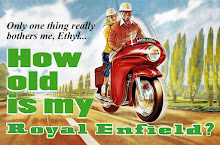 |
| George Joannou brought the Royal Enfield brand to U.S. bicycles. |
The Royal Enfield brand's brief and mysterious appearance on bicycles in the United States in the 1970s and '80s led me to learn that they were imported (from Asian makers) and distributed by the
G. Joannou Co. of New Jersey.
Thanks to a Royal Enfield motorcycle (and bicycle) enthusiast who signs himself Al in Philadelphia, much of the mystery is now solved. He pointed me to the
Bicycle Restoration Yahoo group, which has posted a 1983 Royal Enfield bicycle catalog on the Internet.
The 1983 catalog identifies the G. Joannou Cycle Company, Inc. as "Exclusive Importers/Distributors" of Royal Enfield bicycles. The bikes were "Available immediately from both our Northvale, N.J. and Miami, Fla. warehouses."
The founder's photo appeared inside the front cover with this caption:
"George Joannou, world renown as the leading authority and original pioneer of Lightweight English bicycles to the United States, began importation of Bicycles to the U.S. in 1937. It was through his persistent drive that he was able to change the American consumer from a heavy-weight balloon tire bicycle to the Lightweight English design cycle which has gained popularity today.
"With his spirit and dedication to the bicycle industry, George Joannou built the ROYAL ENFIELD line as it is today."
While that may have been true, the catalog did offer a heavyweight beach cruiser with whitewall balloon tires, a Stingray-style children's bike and three BMX models, all of them distinctly American in appeal.
The range was broad rather than deep. There was something for everyone. (An additional factor to keep in mind is that many of these bicycles came in three sizes to fit humans of different heights. It makes for an extensive catalog.)
Prices ranged from $61.50 for the Gemini child's bicycle with training wheels to $335 for the 12-speed AERO Grand Prix.
The Village-Velo adult tricycle cost up to $145 for the top-of-the-line three-speed with coaster brake.
 |
| Brittany I, an English looking lightweight bicycle. |
The Brittany I (men's) and Brittany II (women's) were the classic English three-speed models with "the Original Sturmey Archer 3/Speed hub for smooth shifting, upright tourist handlebars, and padded saddle."
 |
| The Village-Velo with three speeds and drum brake. |
The Village-Velo tricycle got special attention as it was "originated by George Joannou, is often imitated but never duplicated." It was available in six colors, with single or three-speed transmission, and front caliper or drum brake.
Even the curious Compact
folding model was in the catalog. It was available with one speed or three and in three colors and came standard with a rear rack and fenders.
 |
| The Compact folding bicycle was well equipped. |
Clearly G. Joannou had ambitious hopes. Today, the company is known as
Jamis Bicycles making a very wide range of bikes from cruisers to commuters to competition, fitness, mountain bikes and even "fixies." Some of their sophisticated frames are made of carbon-fiber!
But, unfortunately, none are the evocative "lightweight English" style I love and there are no oddities such as trikes or folding bicycles.
And whatever happened to the Royal Enfield name?



















































